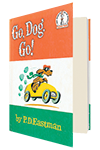The poodle wants the beagle to like her hat. By the end of Go, Dog. Go!, after the hordes of dogs have gone for the last time, the hat seems to be the only thing driving the meandering plot. Who is this poodle? Who is this beagle? Why doesn’t he like her hats, until he does? And why does she care? Author and illustrator P. D. Eastman doesn’t explain, in part because he’s limited himself to only seventy-five different words, from the first dog to the final Good-by. But also for more theoretical reasons—namely, that to capture reality precisely, the postmodern narrator must refuse to capture it fully. It must be left to the reader to piece the world together.
Unlike those that populate the more verbose, rhymed learn-to-read stories like One Fish Two Fish Red Fish Blue Fish, the words in Go, Dog. Go! are more than just valuable sounds. We depend on them because, along with the simple drawings they adorn, they’re all we have to find a story. This is a careful subversion of the genre: rather than comfort the reader with the usual Seussian cocktail of alliterative, rhyme- and assonance-heavy words enumerating detail after detail—see, for example, Fox in Socks: “Duck takes licks in lakes Luke Luck likes. Luke Luck takes licks in lakes duck likes”—the book rejects the very notion that everything to be found in a book can be found in that book. Empty space abounds in Go, Dog. Go!, and the new reader fidgets in the gaps. This is the point. Those gaps—the white abyss behind the dog roller coaster, the trees that grow out of bare-page nothingness—are where meaning resides. The gaps are where fragments of reality refuse to come together, despite authorial intent and despite the reader’s best attempts at deducing a narrative. Thus it is in the gaps that the reader becomes a reader, using what’s on the page to figure out, and sometimes create, what’s off the page. To wit: motives, intent, friendship, and, we might suspect in the final scene—with the poodle and beagle driving off into the sunset—love.
It’s an arduous yet laconic journey to that sunset. The book opens with a single dog, then two dogs, then more, distinguished only by physical differences: some have spotted coats, some have solid coats, some wear clothes....
You have reached your article limit
Sign up for a digital subscription and continue reading all new issues, plus our entire archives, for just $1.50/month.
Already a subscriber? Sign in





